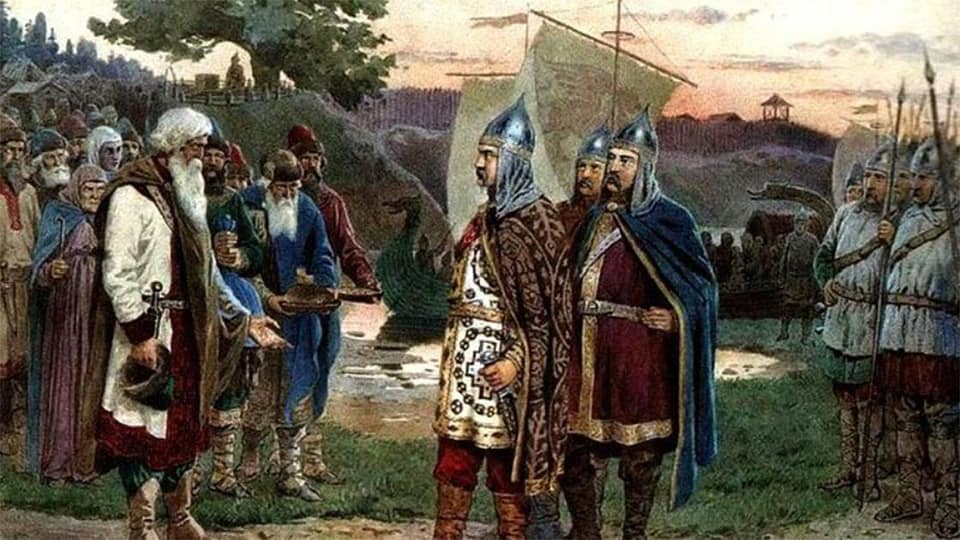Nordic Discovery
Principality of Kiev Rus’ — when Vikings and Slavs cooperated to shape history
The history of the Slavs is a long, ancient story. Their origin comes from a long time ago, from the first chapters in European history books. These culturally, linguistically, and genetically related peoples have inhabited large areas of land across Europe for centuries. Over time, Slavic populations began to emerge: the Polabians of the far North, the Western Slavs, the Southern Slavs, and the Eastern Slavs. And it was these Slavic tribes that later formed the territory of Kiev Rus’.
Much has been written about these ancient Eastern lands and has studied the emergence and history of the Kiev Rus’ State, a medieval federation of East Slavic tribes with a unique history. unique and rich. Today’s modern nations such as Russia, Ukraine and Belarus all have their origins in the Kiev Rus’ State. But who leads this federation? And who were the greatest leaders of this kingdom?
THE BEGINNINGS OF THE PRINCIPAL OF KIEV RUS’
From the beginning, the Baltic Sea coast was inhabited by Slavic tribes. At that time, the Balts, an ancient branch of the Slavs, only developed in the Northwest region of the Baltic Sea coast. From this land, along the South to the Black Sea, is where East Slavic tribes settled for decades, always tending to expand to the East.
To the north, around Novgorod, were settled the Ilmen Slavs, also known as the Slovenes, who were linguistically related to the Polabian Slavs to the west. Their neighbors are the Kryvichi, a union of powerful Slavic tribes. Other neighbors of the Slovenes were the Drevlyans, Volhynians, Polans, Radimichs, Dregovichs, and Vyatichs. North of the Slovenes were the Finnish tribes, mainly the Chud and the Vep. And to the East were the Volga Finns, the Mordvins, the Meryas, the Maris, and the Muromians. Countless ethnic groups, countless languages and different cultures create an interesting and lively scene. Relations between these tribes were relatively peaceful.
The Slavic and Finnish tribes in this area are mostly simple, gentle farmers. They worship the gods of nature. These tribes are mostly large clans, similar to the clans of the Scottish Highlands, or the ancient Serbian tribes of Montenegro.
Because they were so peaceful, these East Slavic and Finnish tribes often had to submit to other tribes that were stronger than them. Around the 9th century AD, these territories came under the influence of the Khazars in the Southeast, and the Varangians in the Northwest. These Varangians were Vikings, mostly Norsemen from Sweden, traveling to the East from the continent’s river system. This river system was protected by Slavic fortresses along its banks. The Varangians began to settle in this land, and imposed “taxes” on these Slavic tribes.
According to the Primary Chronicle, the Slavs fought the Varangians in 862, and pushed them out of this land. But soon, without any centralized leadership, they fell into destabilizing internal conflicts. Many documents also suggest that these tribes decided to invite the Varangians back to govern them, according to Varangian laws, to escape instability. There were three prominent Varangian chieftains who settled in this region as rulers. These are Sineus, Truvor and Rurik, they rule the territories of Izborsk, Beloozero, and Novgorod respectively. Later, only Rurik remained alive, and thus became the sole ruler of the entire territory, the ancestor of the powerful dynasty that ruled Russia until 1610, the Rurikid Dynasty.
HOW THE NORTHERN EUROPEANS FOUNDED KIEV RUS’
But who were these Rus’ people in the land where the Rurikid Dynasty began to dominate? To this day, the origins of the Rus’ people are still debated. The name Rus’, possibly derived from Proto-Slavic “rusъ”, means “thick, blond hair”. But whether these were Norse immigrants to the lands of the Slavs, or the Slavs themselves, this cannot be confirmed with certainty. But either way, the small Norse population that came to rule the Slavs was quickly assimilated into Slavic society and culture, and their Norse name was “Slavized.”
After Rurik died in 879 AD, his relative Oleg (Helgi in Old Norse) became his successor, with Rurik’s son Igor (Ingvar in Old Norse) remaining. too small to rule. A year after his succession, Oleg of Novgorod led his forces down the Dnieper River to Kiev, conquering several towns along the way. He destroyed the two Norse leaders in Kiev, Askold and Dir, occupied the city, and turned this place into the capital of the Rus’ territories, laying the foundation for the later establishment of the Principality of Kiev Rus’. .
From Kiev, Oleg of Novgorod launched a campaign further along the river system into the Slavic mainland. He conquered the Slavs, imposed rule, taxed them, and consolidated his rule. The region was a highly economically viable location, and the Nordic peoples understood this fact well. The main trade routes passed through Slavic lands, and the area was rich in natural resources, slaves and fur animals. These economic factors gave the Principality of Kiev Rus’ wealth and power to reach even further into the future.
From his new capital, Kiev, Oleg soon launched an ambitious campaign into the heart of the Byzantine Empire: Constantinople. In 907 AD, with support from Slavic warriors, he succeeded in attacking Constantinople, resulting in a trade agreement that greatly benefited the Kiev Rus’.
Oleg’s successor is Igor. He continued the territorial expansion of the Principality of Kiev Rus’, besieging Constantinople twice, in 941 and 944 AD. In 945, he signed a peace treaty with the Byzantines. That same year, Prince Igor was killed by the Slavs while demanding tribute from them. The Slavs bent two tall young birch trees, forced the Prince between them and let them grow again, and in doing so tore him to pieces. He was eventually succeeded by his son, the legendary Sviatoslav I of Kiev.
KIEV RUS’ IDEAL WARRIOR — SVIATOSLAV
In the history of the Principality of Kiev Rus’, Sviatoslav was the first ruler of the Rurikid dynasty to take a Slavic name (Sviato Slav, holy Slav, holy Slav), attesting to the speed of their assimilation into society. Slavic society. It is also possible that Sviatoslav was given this name to further appease the Slavic tribes and make the Rurikid rulers more acceptable.
Sviatoslav ruled from Kiev from 945 until his death in 972 AD and was one of the most prominent rulers of the Principality of Kiev Rus’. His reign was marked by military campaigns to the East and South, leading to the collapse of two regional powers at that time: the First Bulgarian Empire and the Khazar Kingdom of Khazaria.
His rules of rule clearly demonstrate the nature of the Rurikid dynasty. He deliberately divided the Slavs, and from Kiev he successfully conquered and subdued the semi-independent East Slav tribes. He went on to defeat the Alans and the Volga Bulgars. At the same time, he regularly formed alliances with the Pechenegs and Magyars, ancient enemies of the Slavs.
However, Sviatoslav I was the first ruler of the Rurikid dynasty to be completely “Slavized”, although many Norse descendants still debate this. He is depicted as having side curls, a large mustache, and taking oaths before the Slavic gods Perun and Veles.
Sviatoslav’s powerful and influential reign ended abruptly in 972 AD upon his death. To prevent his expansion and further animosity between Kiev Rus’ and the Pechenegs, the Byzantines bribed the Pecheneg Khan to assassinate Sviatoslav. This event occurred at Khortitsa Waterfall.
After Sviatoslav’s death, the history of the Principality of Kiev Rus’ entered an important new page. He had 3 sons, among them, Oleg and Yaropolk by an unknown wife and the other son was Vladimir by a female slave named Malusha. After Sviatoslav’s death, the two sons began to compete for the throne of Kiev Rus’.
The conflict reached its climax when an official war broke out between Yaropolk and Oleg in 976 AD. Oleg was killed in this conflict, leaving only Yaropolk and Vladimir. Upon hearing of his brother’s death, Vladimir fled to his cousin Haakon Sigurdsson’s Scandinavia to avoid assassination. There he gathered a force of Viking mercenaries, and returned to his lands in 980. He then destroyed Yaropolk and became sole ruler of the Principality of Kievan Rus’.
THE PEAK OF POWER UNDER THE KINGDOM OF YAROSLAV I
As ruler, Vladimir brought the Principality of Kiev Rus’ to the pinnacle of power and influence. He became Vladimir the Great, Grand Duke of Kiev Rus’, and continued his territorial expansion. And, based on his political influence at that time, Vladimir replaced the old Slavic polytheism and “Christianized” the entire territory of Kiev Rus’.
As is tradition, when Vladimir died, his sons fought for power. His son Sviatopolk I killed three of his brothers, but was ultimately destroyed by his remaining brother, Yaroslav.
Yaroslav I, also known as Yaroslav the Wise, ruled Kiev Rus’ for a long time, and it was during this time that Kiev Rus’ reached the peak of its military, cultural, and political power. He successfully consolidated his rule, defended his borders, and lobbied against the Byzantines. Furthermore, he proceeded to promulgate the first legal code in Kiev Rus’ history.
Unfortunately, after the death of Yaroslav I, Kiev Rus’ power gradually declined. Regional clans and warlords began to gain more power, contributing to the fragmentation of the kingdom. Furthermore, the succession problem became even more serious because the brothers constantly fought each other for power. From these feuds arose the problem of conflicts and divisions between large cities. This led to the formation of the Novgorod Republic and the Polotsk Principality, both of which hated each other. In the North, the Slavs began to establish their own territory, which was the foundation for the later establishment of the Grand Duchy of Moscow. Another principality also established during this period was the Principality of Vladimir – Suzdal.
All this divisive hatred has created an unstable political situation in the region, causing the once powerful Principality of Kiev Rus’ to gradually decline. When the Mongols invaded Kiev Rus’ territory in the 13th century, the Duchy officially died. It was not until 1547 AD that the territories of the former Kiev Rus’ were united once again into the Russian Empire under Ivan IV the Terrible.

